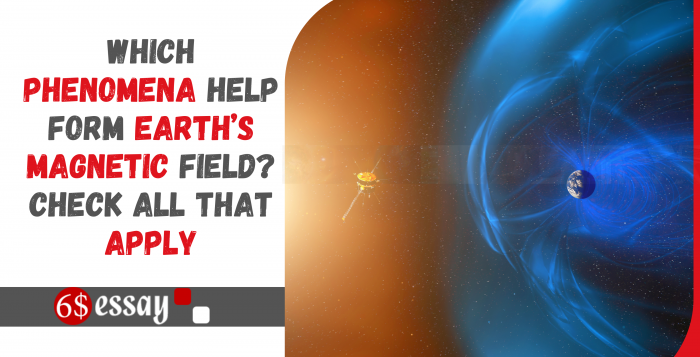February 9, 2024 3:22 pm
Victoria
News

The Earths magnetic field is a remarkable force that plays an important role in the formation of our planets atmosphere. This hidden shield, which originates deep inside the earth, is the result of a complex phenomenon occurring in the core. In this article, we explore various phenomena that play an important role in the formation of the Earths magnetic field. Enhance your educational journey with capestone project writing help. Open new horizons and achieve excellence in your educational endeavours.
Headline 1: Earths internal dynamo
At the Earths core, a dynamic process known as a geodynamo produces a magnetic field. This phenomenon involves the movement of molten iron and nickel in the outer core, driven by the intense heat generated from Earths interior. The continuous flow of these electrically conducting materials produces an electric current, which ultimately produces the magnetic field that surrounds our planet.
Heading 2: Convection current in the outer core
Convection currents within the outer core are a key driver of the geodynamo. As molten iron and nickel heat up near the Earths center, they become less dense and move toward the Earths outer layers. As these materials cool, they become denser and sink back toward the core. This circular motion, known as convection, creates the geodynamo and, consequently, the movement of conductive material necessary to maintain the magnetic field.
Heading 3: Earths rotation and the Coriolis effect
The rotation of the Earth on its axis also plays an important role in the formation of the magnetic field. The Coriolis effect, a result of the Earths rotation, causes moving fluids such as molten iron to collapse. This deflection, in turn, contributes to the generation of geodynamos. The combination of Earths rotation and the Coriolis effect creates a dynamic environment inside the core, increasing the complexity of the magnetic field.
Heading 4: Changes in the Earths Mantle
While the primary driver of the magnetic field is located at the center, phenomena occurring in the Earths mantle can also affect its properties. The mantle, which lies between the core and Earths crust, experiences slow, crawling movements called mantle convection. These movements indirectly affect the behavior of the magnetic field, which shows the interconnectedness of the Earths internal workings.
Headline 5: Effect of magnetic minerals in the Earths crust
The Earths crust is not a passive player in the formation of the magnetic field. Some rocks and minerals in the crust, especially those rich in magnetic materials such as iron oxide, can affect the overall magnetic field. As molten rock solidifies and aligns with the existing magnetic field, it contributes to the regional variations seen in Earths magnetic landscape.
Headline 6: External influences and solar radiation
In addition to internal processes, external factors also contribute to the movements of the Earths magnetic field. The solar wind, a continuous stream of charged particles ejected from the Sun, interacts with the Earths magnetic field – a line that is affected by the magnetic field. This interaction can cause variations and disturbances in the magnetic field, resulting in phenomena such as magnetic storms and auroras.
Heading 7: Plate tectonics and magnetic anomalies
The movement of tectonic plates on the Earths surface is closely related to magnetic anomalies. As new oceanic crust forms on mid-ocean ridges, the minerals in the rocks align with the magnetic field, leaving a record of Earths magnetic history. Scientists study these magnetic anomalies to understand past changes in the magnetic field and to gain insight into Earths geological evolution.
Conclusion:
The Earths magnetic field is a fascinating result of various interconnected phenomena, both deep inside the planet and influenced by external factors. From geodynamos at the core to interactions with the solar wind, these processes collectively create an invisible mold that shapes our planet. Understanding the complexities of this phenomenon not only expands our knowledge of Earths magnetic field but also provides insight into the broader workings of our dynamic planet.



